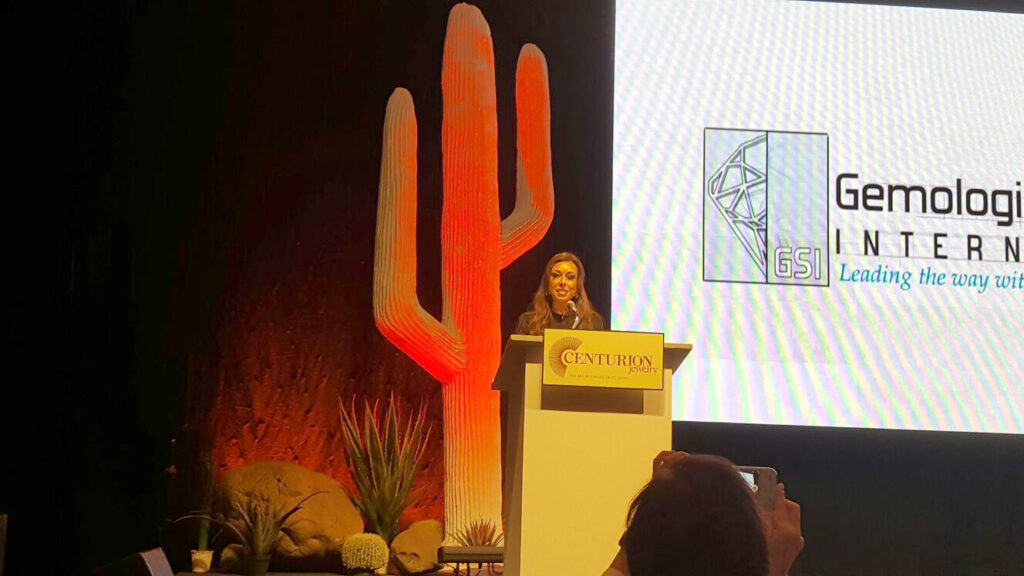Good Morning America: Are Lab-Grown Diamonds the Real Deal?
- By: Debbie Azar
- On:

Shopping for a diamond for a special someone?
Before you make your purchase, you may want to learn more about lab-grown diamonds.

This option has grown in popularity and been seen on celebs such as Bindi Irwin (right).
A lab-grown diamond is formed by scientists who duplicate the diamond-growing process above ground.
The method takes around six to 10 weeks and claims to be more ethical and environmentally conscious than mining.
Lab-grown diamond company Great Heights says the only difference between its diamonds and mined diamonds is their origin.
“A lab-grown diamond is just as real and contains the exact same properties as one that is formed underground,” Alexander Weindling, co-founder and CEO of Great Heights, told “Good Morning America.”
Great Heights’ diamonds are certified by the same gemologists at organizations that certify mined diamonds.
Gemological Science International is one of the labs that certifies lab-grown diamonds, with 13 labs across four continents.

“A diamond is a solid transparent crystalline form of carbon. Lab-grown diamonds have the same optical, chemical and physical properties as natural diamonds,” Debbie Azar, president and co-founder of GSI, told “GMA.”
“However, natural diamonds are formed over billions of years, hundreds of miles beneath the Earth’s surface under truly remarkable conditions. Natural diamonds are unique as no two are ever the same,” Azar added.
If the individuality of the diamonds isn’t as important to you, lab-grown diamonds are easily available at large stores such as Kay Jewelers, Zales, Jared and James Allen.
“Lab-created diamonds are an exceptional mix of master craftsmanship and science,” said Colleen Rooney, the SVP and chief communications officer at Signet Jewelers. “Like natural diamonds, they are comprised of carbon, and exhibit the identical optical, chemical and physical properties as natural diamonds.”

Why are People Choosing Lab-Grown Diamonds?
According to Great Heights, lab-grown diamonds are as much as 40% to 60% less expensive than naturally mined diamonds.
They are also viewed as more ethical and environmentally friendly because they bypass the traditional mining process.
“Consumers are looking for sustainable alternatives, even when it comes to diamonds,” Ryan Bonifacino co-founder and president of Great Heights, said. “Lab-grown diamonds are environmentally conscious, ethical and cost-effective,”Azar said.
Do They Look the Same?
Azar said that visually, lab-grown diamonds look just like naturally mined diamonds.
“No one can identify the origin of a diamond just by looking at it,” she added.
Previously published in Good Morning America
About The Author
 Debbie Azar is the Co-Founder and President of Gemological Science International (GSI), one of the largest gemological organizations in the world, and a distinguished leader in the global diamond and jewelry industry. As an executive with extensive knowledge of the jewelry and gem lab industries, her entrepreneurial skills and vision have helped GSI achieve rapid and continuous growth worldwide, establishing 13 leading-edge gemological facilities on four continents. She currently serves on the boards of the Jewelers Vigilance Committee, Responsible Jewellery Council, and Jewelers for Children, and is a member of the 24 Karat Club of New York. She has been featured in Forbes, Daily Mail, Good Morning America, Bloomberg, Bloomberg Businessweek, Fox Business, Fox5, CBS2, BOLDTV, Varney&Co, The Street, and NASDAQ, among others.
Debbie Azar is the Co-Founder and President of Gemological Science International (GSI), one of the largest gemological organizations in the world, and a distinguished leader in the global diamond and jewelry industry. As an executive with extensive knowledge of the jewelry and gem lab industries, her entrepreneurial skills and vision have helped GSI achieve rapid and continuous growth worldwide, establishing 13 leading-edge gemological facilities on four continents. She currently serves on the boards of the Jewelers Vigilance Committee, Responsible Jewellery Council, and Jewelers for Children, and is a member of the 24 Karat Club of New York. She has been featured in Forbes, Daily Mail, Good Morning America, Bloomberg, Bloomberg Businessweek, Fox Business, Fox5, CBS2, BOLDTV, Varney&Co, The Street, and NASDAQ, among others.

















































